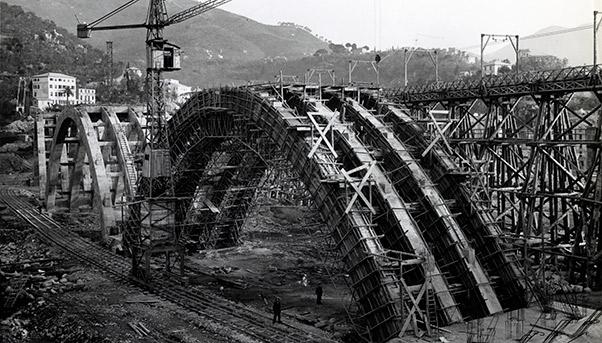The history of Recco Bridge can be divided in two parts: before and after World War II when ferocious Allied bombing between Nov. 10, 1943 and June 28, 1944 struck the small town of the same name on the Ligurian coast.
During those months, the town of some 10,000 inhabitants near Genoa was bombed dozens of times. Its centre and infrastructure suffered a lot of damage, including the Ventimiglia-Genoa-Pisa railway line that linked the country’s northwest with the centre further south. The Recco Bridge, a crucial link on the line, was destroyed.
The bridge had been built a few years after the unification of Italy of 1861. At the beginning of the 1900s, an increase in rail traffic prompted a public debate about the possibility of expanding the line even if the characteristics of the infrastructure that ran along the coastline would make it a difficult feat.
Work to expand it nevertheless began in 1914 and was completed in 1922. Lodigiani, one of Salini Impregilo’s predecessors founded in 1906, took part in the project, concentrating on the section between the towns of Pieve di Sori and Camogli. The task called for the construction of two tunnels located in Recco and Camogli. The first was to be 237.5 metres long and the second 388 metres. Work on the bridge, a curved structure of 376 metres, began simultaneously.
The expansion of the railway line, one of the biggest tasks undertaken by Lodigiani in the sector, soon turned the station at Recco into an important hub between Genoa and Sestri Levante.

But the most difficult challenge for Lodigiani came at the end of World War II when it was called to help rebuild the bridge destroyed by the bombs. Working alongside it would be another founding company of Salini Impregilo, Umberto Girola, which in 1946 was tasked with building the temporary wooden structure for Recco Bridge and restructuring the Sori and Bogliasco viaducts.
In order to reduce the time dedicated to the bridge, Lodigiani built a temporary bridge that it managed to finish and make operative in only four months. Standing 21 metres high, it needed 2,000 cubic metres of wood and 84 tonnes of iron. While some workers were doing their upmost to make the railway line operational, others were busy on the construction of a permanent bridge. In all, 160 workers and 12 specialized carpenters were hired to who work with 180 tonnes of reinforced cement – used for the first time in Italy – and 16.4 tonnes of steel.
Apart from the technical skill that allowed the railway line to start serving trains again in a relatively short time, the bridge itself became a landmark to the country’s success in recovering from the ravages of war. Its story represents the pride and sacrifice shown by the citizens of Recco who withstood and survived the Allied bombings, an acknowledgement of which was eventually made in 1992 by the president of the republic when he conferred upon them the Gold Medal for Valor.

